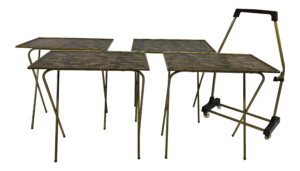
My daughter and son were born in 1986 and 1988. We lived in a small northwest Arkansas town with a population of about 12,000 back then. Yet, times had changed such from the 60’s of my youth that they were supervised when they were outside. They either played in the fenced back yard or on the concrete driveway in the front. Leaving our property was not allowed.
What a contrast to the simpler days of our childhoods.
It was not uncommon for me to get out of bed in the morning, get dressed, and head out the door, not to return until dinnertime. And mom didn’t have a problem with it, as long as I stayed out of trouble. The thought of keeping me home out of fear of being abducted or the like was unthinkable. After all, that sort of thing only took place in big cities, not little towns like Miami, Oklahoma.
The movie Stand By Me portrayed such a day in the life of the Boomer child. A group of kids traveled unsupervised several miles to see the body of a kid who had been hit by a train. While I never saw any dead bodies while growing up, I was free to go anywhere I wanted, as long as I was back before dark. In the summer, this might mean not returning until 8:30 at night.
There was plenty to do to keep a kid occupied. For instance, just a block away was an abandoned house. What a great place for kids to gather! We would use it as an army fort, rob it like a bank, or fight an imaginary fire as it burned to the ground. Writing on its walls was great guilty fun, as well.
Next to it was a big drainage ditch that had a small culvert that ran under the street to the other side. It was just big enough for a kid to walk through. Again, it was perfect for playing army, the game of choice for kids who watched lots of Rat Patrol.

A mile or so from the house was a small wooded area. I spent many summer hours there, getting bitten and stung by loads of little blood sucking parasites and not caring a whit. It was a blast playing in real trees like were available out in the country. Many an adventure involving Daniel Boone, the Cartwrights, and Indians was had there.
Another favorite gathering spot for us kids was the wading pool. The city had a small circular pool about two feet deep that was free and open to the public. I was free to go there any time I wanted. The city even paid a lifeguard to keep an eye on things, running on the sidewalk being the commonest violation to be pointed out with a sharp whistle.
I recall a beautiful blonde teenaged girl who worked lifeguard one summer. I think she might have been the first one I ever fell in love with, at the age of six. Her name was Cassie Gaines, and she was destined for tragic immortality. She became a vocalist with Lynyrd Skynyrd, and on October 20, 1977, was killed in the infamous plane crash.
The various moms of the neighborhood took it upon themselves to feed whatever kids happened to be at their home at lunchtime. We bounced around enough from home to home that it all evened out for them. Today, might require eight bologna sandwiches, tomorrow everyone would be eating at three houses down the street.
And our parents were never worried. They all knew the neighbors, and everyone trusted everyone else. Occasionally, I would be told to not go to a certain home. Later, I would find that would mean the mother or father was an alcoholic or the like. And I would never question the restriction. I had a lot of freedom, and kept it by behaving myself.
Alas, changing times removed that blissful freedom to go anywhere from my own kids. Nowadays, I imagine parents watch their children like hawks. But think back to your own childhood and you can likely remember a time when it was common to take off and play all day in various locations all over your town.
















